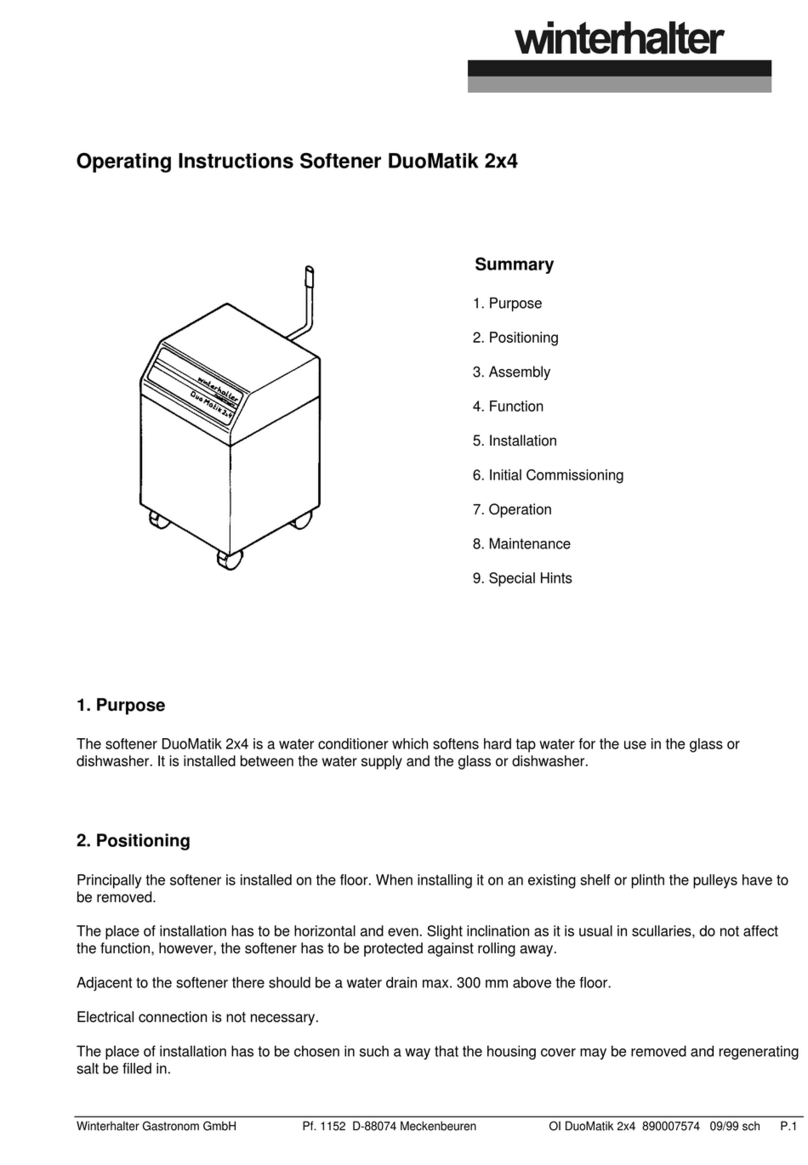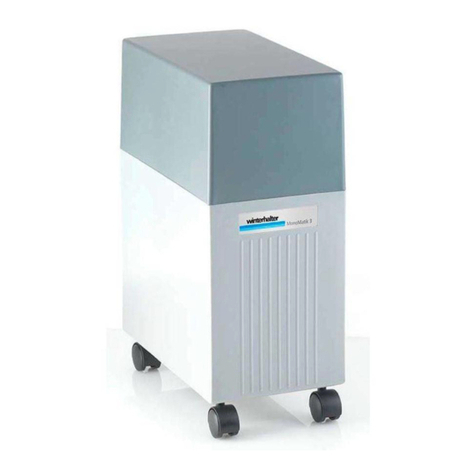7
Operating instructions
for the Winterhalter DuoMatik 3 softener
1 Safety notes
For safe use of the softener, please read the
safety notes listed here carefully.
1.1 Explanation of symbols used
The following symbols are used in these instructions:
Caution
Warns of potential defects or destruction of the
product when the provided safety measures are
not observed.
IMPORTANT An important tip is given here.
INFO A useful tip is given here.
These arrows indicate procedural instructions.
This symbol indicates the results of your actions.
This symbol indicates lists
1.2 Intended use
The DuoMatik 3 softener is a device for water softening of fresh
water for use in commercial warewashers and may only be used
for this purpose. The softener is installed between the fresh water
pipe and the warewasher. The fresh water must be of drinking wa-
ter quality from a microbiological point of view.
The softener is a technical piece of equipment for commercial use
and is not intended for private use.
Any alterations to the design or to use of the device performed
without the written approval of Winterhalter Gastronom GmbH will
lead to the guarantee and product liability becoming void.
Winterhalter Gastronom GmbH will not accept liability for any
damage caused by failure to use the device in accordance with
the intended use.
1.3 Safety notes for maintenance and repairs
Maintenance and repairs may only be performed by authorised
Winterhalter service technicians. Unprofessional maintenance or
repairs may lead to considerable dangers for the user for which
Winterhalter cannot be held liable.
Only original spare parts by Winterhalter may be used for mainte-
nance or repairs. Use of spare parts that are not original spare
parts invalidates the warranty.
1.4 General safety notes
Read the safety and operational notes included in these operating
instructions carefully. Keep these operating instructions in a safe
place for later reference. Failure to observe the safety notes and
operating instructions voids all liability and warranty claims against
Winterhalter Gastronom GmbH.
Only work with the softener after reading and understanding the
operating instructions. Winterhalter Customer Service will be glad
to provide you with information on how to operate the device and
how it functions. The softener may only be operated as described
in these operating instructions.
2 Product description
The softener consists of a mobile plastic container and a removable
cover. The regeneration salt is placed into the container.
Two cartridges are integrated into the container. The cartridges are
filled with exchange resin and are connected together.
Water softening is based on the principle of ion exchange. The
exchange resin in the cartridges binds with the hardening ions from
the raw water flowing through the device and releases other non-
hardening ions into the water. The softened water has a total hard-
ness of 0 °dH.
The capacity of the exchange resin is limited. It depends on the total
hardness of the raw water. The exchange resin must be regenerated
when it has been used up. The control head on the cartridges con-
trols regeneration depending on the water hardness set. When a
cartridge is depleted the unit switches to the second cartridge, and
the depleted cartridge is regenerated, ensuring that softened water is
continuously available.
3 Installation and connection
3.1 Installation site requirements
The room must be frost-free.
A water drain must be located near the softener. The water drain
must not be higher than the safety overflow on the rear of the sof-
tener.
Ideally the room has a floor drain.
The installation location must be horizontal and even. Slight incli-
nations such as are usual in kitchens do not impair functioning,
however the softener should be secured against rolling.
The softener should preferably be installed on the floor. If the
softener is placed on a base, the castors should be removed.
There should be sufficient space above to ensure that the cover
can be removed easily during the refilling of regeneration salt.
See connection diagram for connections for water inlet and water
drain (page 10).
3.2 Preparing control head
Remove the cover of the container.
Take the hoses and assembly kit out of the container.
Equip the adapters (1) with the O-rings (2) and grease with sili-
cone grease.
Plug the adapters (1) onto the "in" and "out" connections.
Secure with handle (4) and pin (3).
3.3 Connecting
Caution
Connection of the softener to the drinking water network
and to the waste water must be performed according to
the country-specific, local conditions by an approved
water fitter.
National installation and operating regulations as well as
details on the connection diagram on page 10 must be
observed.
03 / 2017-02





























